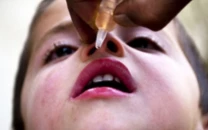Health matters: Maternal mortality high despite solutions availability
Experts cite education, improving basic facilities as ways to address the issue.

Around four per cent of the women were under 20 and 34.2% had less than five years of schooling. PHOTO: FILE
Severe maternal illnesses occur in 12 out of every 1,000 live births in Pakistan. This was among other statistics in the World Health Organisation Multi-country Survey on Maternal and Newborn Health (WHOMCS) 2010-11, which was launched on Wednesday at Pakistan Institute of Medical Sciences (Pims).
Severe anaemia, postpartum haemorrhages and preeclampsia were the most common maternal complications in the country, it adds.
The survey was conducted from May 2010 to December 2011. It was based on 314,623 women at 16 facilities in Punjab, Sindh and Islamabad, who were studied to determine the occurrence and management of maternal and neonatal problems.
Around four per cent of the women were under 20 and 34.2% had less than five years of schooling.
According to the survey, severe anaemia occurred in 50% of women, postpartum haemorrhage in 48.5% and preeclampsia in 9.1%.
Heart, breathing and blood-related problems were the most prevalent among women with severe maternal outcomes, with rates ranging from 34.1% to 59.1%.

There were 94 near-miss maternal mortality cases and 38 maternal deaths, giving a maternal mortality ratio of 299 per 100,000 births.
The WHO observed that the maternal mortality rate in Pakistan was two to three times higher than its assessments for other high mortality countries, even though the interventions needed to reduce mortality were widely available.
Meanwhile, the overall caesarean section rate was 34.5%, while the prevalence of low birth weight and preterm births were 10.9% and 11.2%, respectively.
Talking to The Express Tribune, senior gynaecologists at public hospitals in the twin cities of Islamabad and Rawalpindi said one of the major causes of high maternal mortality is the shortage of beds, staff and other facilities at public hospitals.
Holy Family Hospital (HFH) Head of Obstetrics Dr Rizwana Chaudhry said there are 250 beds at the HFH gynaecology department --- where over 17,000 deliveries are performed every year --- and they are being shared by two to three women at a time.
“Government-run tertiary care hospitals are over-burdened because of the pathetic condition of primary healthcare centres in rural areas,” she said.
Dr Chaudhry also expressed concern over the absence of a centralised data collection system at all levels to record maternal deaths.
“Education is the best way to reduce maternal and neonatal mortality,” she said.
Dr Nasira Tasneem, an associate professor of gynaecology at Pims, said there is an acute shortage of doctors, nurses and beds at the hospital.
At present, there are 60 regular staff members, most of whom are postgraduate trainees who are not trained well enough to handle complicated cases. Besides this, there are 80 nurses and six medical officers in two units, she said.
Every day, over 500 patient’s visits the outpatient department, while the 125 beds are being shared by three patients at a time. On average, 13,000 deliveries are performed every year, 12 to 15 of which result in maternal deaths due to complications, she said.
“In Pakistan maternal mortality can be reduced if primary healthcare services at grassroots levels are improved and urban hospitals upgraded,” she said.
Published in The Express Tribune, April 11th, 2013.



















COMMENTS
Comments are moderated and generally will be posted if they are on-topic and not abusive.
For more information, please see our Comments FAQ